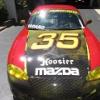This is a long one but I won’t apologize for that, some topics require more than a sound bite or tweet.
Frank, et al, I’m generally leaning toward your point of view in terms of final outcome but let’s not lose sight of 18 years of some fundamental rules and a concerted effort for the past six or so to reign back in those who stretch them.
The number one rule has never changed, if it doesn’t say you can then you can’t. Admittedly there are obvious common sense holes in that, but we needed a rule added explicitly allowing us to remove the horn, so pretty strict. We know that tech looks at anything that appears to have been modified. Like it or not, some judgement comes into play regarding the difference between repairs and modifications.
Everyone involved is aware of the rules and that anything even remotely looking like intentional modifications for the purpose of performance (even if reliability can also be claimed) will at the very least get the attention of tech. So when contemplating whether what you are about to do is “legal”, the simple fact that you stopped to contemplate it is a red flag. Not to say you don’t proceed, but you’d better think it through and maybe even get a ruling on it.
As you say, and as I and many others have, aftermarket parts make it all more difficult. As I noted above, the combination of words “exact equivalent” leaves a lot to be desired. If I found an aftermarket control arm commonly listed as being for my Miata, yet the length provided a bit more camber compared to stock, could I use it? I expect we can all agree that the answer is NO, whatever “exact equivalent” means, that isn’t it. If we can agree on that then at least part of your argument weakens, whether the shafts were purchased as-is or modified to match some unicorn part they once found.
But from what NASA has released and other information trickling out, they are looking at multiple aftermarket parts and discussing with major rebuilders how it is done and what variances are expected. But they can’t possibly prove that no reman shafts have ever been sold where the ball passes cleanly through the cage, and they don’t have to. The burden of proof here is arguable but there will always have to be room for judgement in certain cases. It is not reasonable to believe that every cage in each axle was worn enough to explain it, or even that “necessary” cleanup is responsible (particularly given the crudeness of some not exactly looking like a cleanup). So let’s assume they were intentionally modified. Still, if a brand X had been found to be similar then this would probably be over because this is not like my camber example. That was just a useful example to show that aftermarket availability ALONE is not adequate. This is just a CV joint with little potential benefit from modification and few people will ever open one up unless doing their own routine lubrication. Pass a rule disallowing brand X and others like it, everyone is forced to open theirs up. Allow brand X and equivalent DIY and everyone will feel compelled to make the change just in case it matters. Nobody wins except maybe shops offering the service, but that’s the nature of the beast.
The issue of it being a wear item has also been raised to suggest that the opening might enlarge enough for the ball to pass through. That’s a lot of wear and the ball would likely also need to be replaced, at which point a larger ball is used. There are a lot of very old parts out there but so far no such example has been presented AFAIK. Let’s lump that in with unicorns for now.
So what to do with this case? First, I think criticism of NASA is totally off base. A few people elsewhere screaming incompetence, witch hunt, not having their shit together, “destroying Spec Miata” etc. I couldn’t disagree more. Given what’s happened in the past and what they found, I think they have done exactly what all the other race participants have a right to expect. The time required is unfortunate, but imagine the erosion in confidence if they had simply swept this under the rug. Been there, doesn’t work, word gets out and everybody is free to believe their own worst case. Give them credit, they are making a major effort to get it right. Give them credit for a very detailed tech effort. Give the racers credit that despite what I think was the most complete tech ever, these silly CV joints were the only thing found!
Sorry, I diverged a bit off topic but those guys REALLY pissed me off.
Back to resolution. If I were king and a common similar aftermarket part is found I vacate the DQs and try to figure out where to go from there.
If an extremely rare/random unicorn can be confirmed then I probably do the same as above, even though I don’t believe for a second that anyone was just copying what they already knew to be available.
If after much searching no such examples are found in the wild and if I firmly believe from consulted experts that they don’t exist barring a manufacturing mistake, I still drop the DQs but find something in the rules that allow me to assess a lesser penalty than positions. Points, probation, fines, whatever.
I’ve never been soft on people stretching the rules, but as I’ve stated in an earlier post the realities of aftermarket parts and the comparison to things like front wheel bearings are relevant factors, and under any circumstances this just isn’t a big deal IMO. The core rule still applies I don’t think this modification passes it, but I also believe in judgement based on other factors. To issue DQs over this seems more than excessive.







 Sign In
Sign In Create Account
Create Account













 Back to top
Back to top Report
Report











